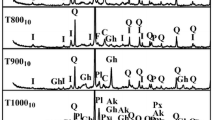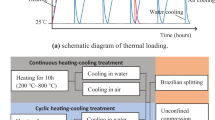Abstract
The acoustic emission (AE) technique was employed to monitor crack formation in the water-saturated ceramic material subjected to freeze–thaw cycles. The samples with water accessible porosity ranging from 6 to 50 vol% were prepared from the illite-rich clay by the sacrificing template method. The experimental samples were fired to 1100 °C in the static air atmosphere. Afterward, they were saturated with distilled water and subjected to the freeze–thaw cycles in the temperature range from − 22 to 20 °C. The AE signals occurred repeatedly during freeze–thaw cycling and they were attributed to the formation of microcracks in the ceramic body. The intensity of microcracking increased with increasing porosity. The microcracks were created primarily during the freezing stages of the experiment. Nevertheless, a considerable number of microcracks also appeared during thawing, especially in the ceramic body with pores below 1 μm. The microcracking during thawing was attributed to the reabsorption of water by tiny pores.









Similar content being viewed by others
References
ASTM C 666/C 666M-03, ASTM Standard C 666/C 666M-03, ASTM C 666/C 666M-03: Standard Test Method for Resistance of Concrete to Rapid Freezing and Thawing. ASTM International, Philadelphia, USA (2003)
Standard Test Method for Measuring the Resistance of Ceramic Tile to Freeze-Thaw Cycling (2002)
Ikeda, K., Kim, H.S., Kaizu, K., Higashi, A.: Influence of firing temperature on frost resistance of roofing tiles. J. Eur. Ceram. Soc. 24, 3671–3677 (2004). https://doi.org/10.1016/j.jeurceramsoc.2003.12.014
Maage, M.: Frost resistance and pore size distribution in bricks. Matériaux Constr. 17, 345–350 (1984)
Šveda, M., Sokolář, R.: The effect of firing temperature on the irreversible expansion, water absorption and pore structure of a brick body during freeze–thaw cycles. Mater. Sci. 19, 465–470 (2013). https://doi.org/10.5755/j01.ms.19.4.2741
Pigeon, M., Pleau, R.: Modern Concrete Technology 4: Durability of Concrete in Cold Climates. Taylor & Francis, London (2010)
Šveda, M.: Effect of water absorption on frost resistance of clay roofing tiles. Br. Ceram. Trans. 102, 43–45 (2003). https://doi.org/10.1179/096797803225009210
Powers, T.C.: The air requirement of frost-resistanc concrete. Proc. Highw. Res. Board. 29, 184–211 (1949)
Powers, T.C., Helmuth, R.A.: Theory of volume changes in hardened Portland cement pastes during freezing. Proc. Highw. Res. Board. 32, 285–297 (1953)
Powers, T.C.: Freezing Effects in Concrete. American Concrete Institute, Deroit (1975)
Litvan, G.G.: Phase transitions of adsorbates. III. Heat effects and dimensional changes in nonequilibrium temperature cycles. J. Colloid Interface Sci. 38, 75–83 (1972). https://doi.org/10.1016/0021-9797(72)90221-4
Litvan, G.G.: Phase transitions of adsorbates: IV, mechanism of frost action in hardened cement pastes. J. Am. Ceram. Soc. 55, 38–42 (1972). https://doi.org/10.1080/01411599908224536
Knapek, M., Húlan, T., Minárik, P., Dobroň, P., Štubňa, I., Stráská, J., Chmelík, F.: Study of microcracking in illite-based ceramics during firing. J. Eur. Ceram. Soc. 36, 221–226 (2016). https://doi.org/10.1016/j.jeurceramsoc.2015.09.004
Húlan, T., Štubňa, I., Kaljuvee, T., Csáki, Š, Knapek, M., Dobroň, P., Chmelík, F.: Acoustic emission of Estonian clay Arumetsa during firing. AIP Conf. Proc. 1988 (2018). https://doi.org/10.1063/1.5047610
Qian, Y., Farnam, Y., Weiss, J.: Using acoustic emission to quantify freeze-thaw damage of mortar saturated with NaCl solutions. Proc. 4th Int. Conf. Durab. Concr. Struct. (2014). https://doi.org/10.5703/1288284315379
Li, W., Pour-Ghaz, M., Castro, J., Weiss, J.: Water absorption and critical degree of saturation relating to freeze–thaw damage in concrete pavement joints. J. Mater. Civ. Eng. 24, 299–307 (2012). https://doi.org/10.1061/(ASCE)MT.1943-5533.0000383
Pazdera, L., Topolar, L.: Application acoustic emission method during concrete frost resistance. Russ. J. Nondestruct. Test. 50, 127–131 (2014). https://doi.org/10.1134/S1061830914020065
Farnam, Y., Bentz, D., Hampton, A., Weiss, W.J.: Acoustic emission and low-temperature calorimetry study of freeze and thaw behavior in cementitious materials exposed to sodium chloride salt. Transp. Res. Rec. 2441, 81–90 (2014). https://doi.org/10.3141/2441-11
Farnam, Y., Bentz, D., Sakulich, A., Flynn, D., Weiss, J.: Measuring freeze and thaw damage in mortars containing deicing salt using a low-temperature longitudinal guarded comparative calorimeter and acoustic emission. Adv. Civ. Eng. Mater. 3, 20130095 (2014). https://doi.org/10.1520/acem20130095
Húlan, T., Knapek, M., Minárik, P., Csáki, Š., Kaljuvee, T., Uibu, M.: Assessing the frost resistance of illite-based ceramics through the resonant frequency of free vibration and internal damping. In: Medved’, I., Avsec, J., and Trník, A. (eds.) AIP Conference Proceedings. p. 040015. American Institute of Physics Inc., 22nd International Meeting of Thermophysics 2017, THERMOPHYSICS 2017 and 4th Meeting of the Conference Energy and Responsibility, EnRe 2017; Terchova; Slovakia; 12 September 2017 through 14 September 2017 (2017)
Húlan, T., Trník, A., Štubňa, I., Bačík, P., Kaljuvee, T., Vozár, L.: Development of Young’s modulus of illitic clay during heating up to 1100 °C. Mater. Sci. 21, 429–434 (2015). https://doi.org/10.5755/j01.ms.21.3.7152
Csáki, Š, Ondruška, J., Trnovcová, V., Štubňa, I., Dobroň, P., Vozár, L.: Temperature dependence of the AC conductivity of illitic clay. Appl. Clay Sci. 157, 19–23 (2018). https://doi.org/10.1016/j.clay.2018.02.026
Sedmale, G., Randers, M., Rundans, M., Seglins, V.: Application of differently treated illite and illite clay samples for the development of ceramics. Appl. Clay Sci. 146, 397–403 (2017). https://doi.org/10.1016/j.clay.2017.06.016
Wang, G., Wang, H., Zhang, N.: In situ high temperature X-ray diffraction study of illite. Appl. Clay Sci. 146, 254–263 (2017). https://doi.org/10.1016/j.clay.2017.06.006
Húlan, T., Knapek, M., Štubňa, I., Trník, A.: The microcracking in illite-based ceramics followed by acoustic emission. In: Noise and Vibration in Practice: Peer-Reviewed Scientific Proceedings. pp. 71–76. STU, Bratislava (2016)
Monteiro, S.N., Vieira, C.M.F.: The role of particle shape on the sintering of clay based ceramics. Mater. Sci. Forum. 660–661, 88–93 (2010). https://doi.org/10.4028/www.scientific.net/MSF.660-661.88
Heimann, R.B.: Classic and Advanced Ceramics: From Fundamentals to Applications. Wiley, Weinheim (2010)
Landry, M.R.: Thermoporometry by differential scanning calorimetry: Experimental considerations and applications. Thermochim. Acta. 433, 27–50 (2005). https://doi.org/10.1016/j.tca.2005.02.015
Acknowledgements
This work was financially supported by the Czech Science Foundation (Grant No. 17-16772S), by the grant VEGA 1/0810/19 from the Ministry of Education of the Slovak Republic, and by the institutional research funding body (Grant No. IUT33-19) of the Estonian Ministry of Education and Research. M.K. acknowledges financial support from OP RDE, MEYS (Grant No. CZ.02.1.01/0.0/0.0/16 013/0001794).
Author information
Authors and Affiliations
Corresponding author
Additional information
Publisher’s Note
Springer Nature remains neutral with regard to jurisdictional claims in published maps and institutional affiliations.
Rights and permissions
About this article
Cite this article
Húlan, T., Knapek, M., Csáki, Š. et al. The Formation of Microcracks in Water-Saturated Porous Ceramics During Freeze–Thaw Cycles Followed by Acoustic Emission. J Nondestruct Eval 40, 13 (2021). https://doi.org/10.1007/s10921-020-00748-4
Received:
Accepted:
Published:
DOI: https://doi.org/10.1007/s10921-020-00748-4




